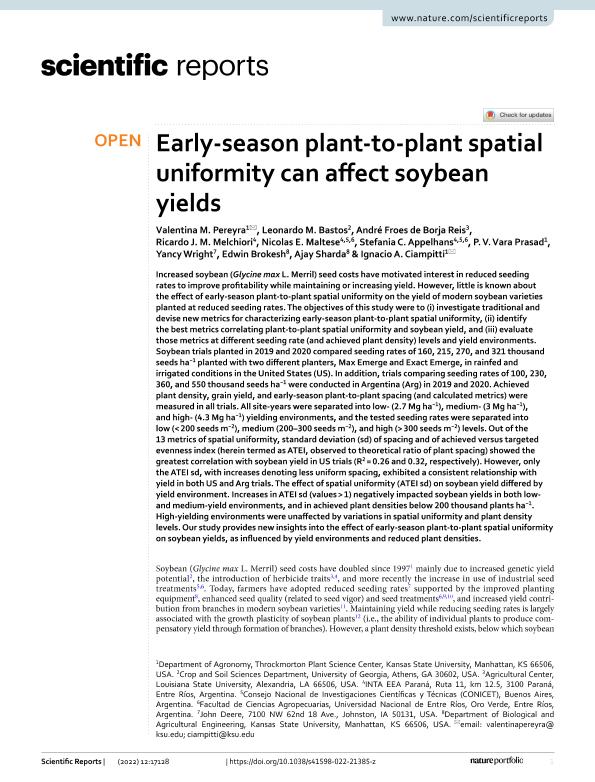Mostrar el registro sencillo del ítem
dc.contributor.author
Pereyra, Valentina M.
dc.contributor.author
Bastos, Leonardo M.
dc.contributor.author
Froes de Borja Reis, André
dc.contributor.author
Melchiori, Ricardo J. M.
dc.contributor.author
Maltese, Nicolás Elías

dc.contributor.author
Appelhans, Stefania Carolina

dc.contributor.author
Vara Prasad, P. V.
dc.contributor.author
Wright, Yancy
dc.contributor.author
Brokesh, Edwin
dc.contributor.author
Sharda, Ajay
dc.contributor.author
Ciampitti, Ignacio Antonio

dc.date.available
2024-01-02T14:48:00Z
dc.date.issued
2022-10
dc.identifier.citation
Pereyra, Valentina M.; Bastos, Leonardo M.; Froes de Borja Reis, André; Melchiori, Ricardo J. M.; Maltese, Nicolás Elías; et al.; Early-season plant-to-plant spatial uniformity can affect soybean yields; Nature; Scientific Reports; 12; 1; 10-2022; 1-10
dc.identifier.issn
2045-2322
dc.identifier.uri
http://hdl.handle.net/11336/222004
dc.description.abstract
Increased soybean (Glycine max L. Merril) seed costs have motivated interest in reduced seeding rates to improve profitability while maintaining or increasing yield. However, little is known about the effect of early-season plant-to-plant spatial uniformity on the yield of modern soybean varieties planted at reduced seeding rates. The objectives of this study were to (i) investigate traditional and devise new metrics for characterizing early-season plant-to-plant spatial uniformity, (ii) identify the best metrics correlating plant-to-plant spatial uniformity and soybean yield, and (iii) evaluate those metrics at different seeding rate (and achieved plant density) levels and yield environments. Soybean trials planted in 2019 and 2020 compared seeding rates of 160, 215, 270, and 321 thousand seeds ha−1 planted with two different planters, Max Emerge and Exact Emerge, in rainfed and irrigated conditions in the United States (US). In addition, trials comparing seeding rates of 100, 230, 360, and 550 thousand seeds ha−1 were conducted in Argentina (Arg) in 2019 and 2020. Achieved plant density, grain yield, and early-season plant-to-plant spacing (and calculated metrics) were measured in all trials. All site-years were separated into low- (2.7 Mg ha−1), medium- (3 Mg ha−1), and high- (4.3 Mg ha−1) yielding environments, and the tested seeding rates were separated into low (< 200 seeds m−2), medium (200–300 seeds m−2), and high (> 300 seeds m−2) levels. Out of the 13 metrics of spatial uniformity, standard deviation (sd) of spacing and of achieved versus targeted evenness index (herein termed as ATEI, observed to theoretical ratio of plant spacing) showed the greatest correlation with soybean yield in US trials (R2 = 0.26 and 0.32, respectively). However, only the ATEI sd, with increases denoting less uniform spacing, exhibited a consistent relationship with yield in both US and Arg trials. The effect of spatial uniformity (ATEI sd) on soybean yield differed by yield environment. Increases in ATEI sd (values > 1) negatively impacted soybean yields in both low- and medium-yield environments, and in achieved plant densities below 200 thousand plants ha−1. High-yielding environments were unaffected by variations in spatial uniformity and plant density levels. Our study provides new insights into the effect of early-season plant-to-plant spatial uniformity on soybean yields, as influenced by yield environments and reduced plant densities.
dc.format
application/pdf
dc.language.iso
eng
dc.publisher
Nature

dc.rights
info:eu-repo/semantics/openAccess
dc.rights.uri
https://creativecommons.org/licenses/by/2.5/ar/
dc.subject
GLYCINE MAX
dc.subject
SEEDING RATE
dc.subject
UNIFORMITY
dc.subject
YIELD ENVIRONMENTS
dc.subject.classification
Agricultura

dc.subject.classification
Agricultura, Silvicultura y Pesca

dc.subject.classification
CIENCIAS AGRÍCOLAS

dc.title
Early-season plant-to-plant spatial uniformity can affect soybean yields
dc.type
info:eu-repo/semantics/article
dc.type
info:ar-repo/semantics/artículo
dc.type
info:eu-repo/semantics/publishedVersion
dc.date.updated
2024-01-02T11:45:14Z
dc.journal.volume
12
dc.journal.number
1
dc.journal.pagination
1-10
dc.journal.pais
Reino Unido

dc.description.fil
Fil: Pereyra, Valentina M.. Kansas State University; Estados Unidos
dc.description.fil
Fil: Bastos, Leonardo M.. University of Georgia; Estados Unidos
dc.description.fil
Fil: Froes de Borja Reis, André. State University of Louisiana; Estados Unidos
dc.description.fil
Fil: Melchiori, Ricardo J. M.. Instituto Nacional de Tecnología Agropecuaria. Centro Regional Entre Ríos. Estación Experimental Agropecuaria Paraná; Argentina
dc.description.fil
Fil: Maltese, Nicolás Elías. Consejo Nacional de Investigaciones Científicas y Técnicas; Argentina. Universidad Nacional de Entre Ríos. Facultad de Ciencias Agropecuarias; Argentina
dc.description.fil
Fil: Appelhans, Stefania Carolina. Consejo Nacional de Investigaciones Científicas y Técnicas; Argentina. Universidad Nacional de Entre Ríos. Facultad de Ciencias Agropecuarias; Argentina
dc.description.fil
Fil: Vara Prasad, P. V.. Kansas State University; Estados Unidos
dc.description.fil
Fil: Wright, Yancy. No especifíca;
dc.description.fil
Fil: Brokesh, Edwin. Kansas State University; Estados Unidos
dc.description.fil
Fil: Sharda, Ajay. Kansas State University; Estados Unidos
dc.description.fil
Fil: Ciampitti, Ignacio Antonio. Kansas State University; Estados Unidos
dc.journal.title
Scientific Reports
dc.relation.alternativeid
info:eu-repo/semantics/altIdentifier/url/https://www.nature.com/articles/s41598-022-21385-z
dc.relation.alternativeid
info:eu-repo/semantics/altIdentifier/doi/http://dx.doi.org/10.1038/s41598-022-21385-z
Archivos asociados
